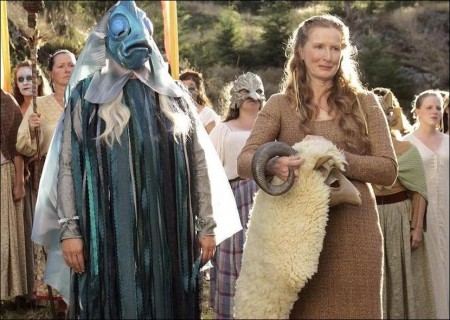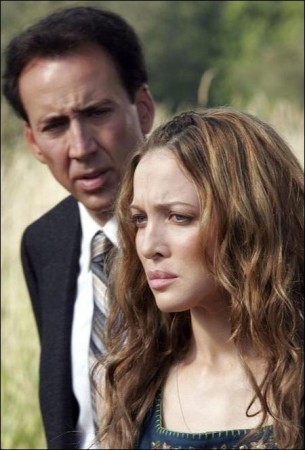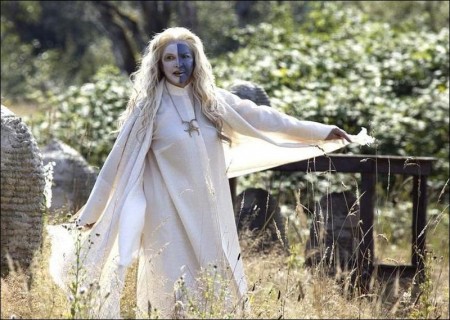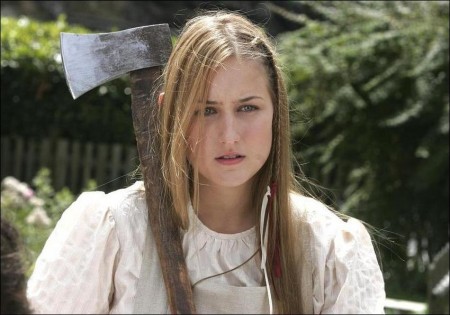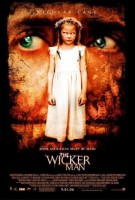Tagline: Some sacrifices must be made.
A reclusive lawman (Nicolas Cage) travels to a secluded island to search for a girl who has gone missing. Once there, he discovers sinister forces at work among the island’s secretive residents, including strange sexual rituals, a harvest festival and possible human sacrifice. Neil LaBute directs this remake of the 1973 British horror classic.
Out patrolling a California highway, police officer Edward Malus (Nicolas Cage) stops a station wagon to return a little girl’s lost doll. Moments later, a runaway truck slams into the station wagon, igniting it into a fiery wreck with the mother and child trapped inside. Edward fails to save them before the car explodes… and then spends months of his life choking down pills to get the image of their faces out of his head. But Edward is about to get a second chance.
A desperate letter from his former fiancée, Willow (Kate Beahan), arrives at his home with no postmark. Willow came into his life and left just as unexpectedly years before. But now, her daughter Rowan has gone missing, and Edward is the only person she trusts to help locate her. She asks him to come to her home on a private island- Summersisle-a place with its own traditions where people observe a forgotten way of life. Edward seizes the opportunity to make his life right again, and soon finds himself on a seaplane bound for the islands of the Pacific Northwest.
But nothing is what it seems on isolated Summersisle, where a culture, dominated by its matriarch Sister Summersisle (Ellen Burstyn), is bound together by arcane traditions and a pagan festival known as “the Day of Death and Rebirth.” The secretive people of Summersisle only ridicule his investigation, insisting that a child named Rowan never existed there…or if she ever did was no longer alive.
But what Edward doesn’t know is that Willow’s plea for help has invited more into his life than a chance for redemption. In unraveling Summersisle’s closely held secrets, Edward is drawn into a web of ancient traditions and murderous deceit, and each step he takes closer to the lost child brings him one step closer to the unspeakable. And one step closer to The Wicker Man.
About the Production
Academy Award winner Nicolas Cage and acclaimed director Neil LaBute both share an enduring fascination with the British film “The Wicker Man.” The 1973 U.K. production starred Edward Woodward, Christopher Lee and Britt Ekland and was directed by Robin Hardy. Though not widely known at the time, the film captivated an increasing cult following in the ensuing years.
Cage’s first exposure to it was at the home of legendary punk rock star and movie buff, the late Johnny Ramone. Cage recalls, “It wasn’t like any movie that I had experienced before. It was very disturbing. Any movie that can make me feel like that has something very powerful about it.”
Adds producer Norm Golightly, Cage’s partner at Saturn Films, “A lot of people may know the title but have never seen the film. However, within a small community, a lot of people know `The Wicker Man’ and worship it.”
“It had this spooky, eerie feeling that just hasn’t been matched, in my opinion,” adds producer Boaz Davidson.
In 1980, writer/director Neil LaBute was working in an art house cinema when he saw the trailer and poster for the original, which opened in the U.S. several years after its U.K. release. “It was one of those films that people either knew intimately or didn’t know anything about,” he remembers. “I loved the story, loved how it ended.
A filmmaker who has also distinguished himself in theater, LaBute’s sensibilities were ideal for a contemporary reimagining of the story of “The Wicker Man.” “Neil is renowned as a writer in the theatre world and with more artistic films,” says producer Randall Emmett, “I thought, `Wow, we can have a genre movie with a real artistic integrity.'”
“Neil loves actors,” adds Cage. “He loves the dynamic of what happens between directing and acting and writing. He’s very hands-on and loves the creative process. It’s been a great joy to work with him on this film.
LaBute, who has garnered acclaim for his searing portrayals of relationships between the sexes in films like “In the Company of Men” and “Your Friends and Neighbors,” relished the opportunity to further explore the gray areas in-between, albeit in an unconventional way. “With this film, I went into a world that was probably closer to the kinds of works that I’ve done previously, in investigating how men and women relate to each other and the kind of power differential that exists between them,” he says.
In remaking “The Wicker Man” more than three decades after the original film, LaBute incorporated a role reversal between the sexes that perhaps would be more readily accepted by today’s audiences: Instead of the men being in charge, it is the women who are very much in control of the society on the mysterious island called Summersisle.
Although LaBute had not previously written specific characters for the actors that play them, he was delighted with the facility with which Cage inhabited the role of Edward Malus. “Coming out of his mouth, the dialog sounded absolutely right and like it was tailored for him, but I never really thought of it that way,” he says. “I tended to just think of the character because I know Nic’s strengths and his chameleon-like ability to become whoever. Nicolas Cage makes Edward a very human character.”
Cage stars as Edward Malus, a highway cop content to patrol a lonely stretch of road in the California countryside. “He’s the kind of man who is very happy doing what he does,” says Cage. “He has his beliefs and what he believes in is the law.”
Edward’s life is interrupted by a devastating event in which he blames himself for the fiery deaths of a young mother and her daughter. “The accident puts him into a more fractured state of mind,” explains Cage. “He’s fragile; he’s having some difficulty with anxiety, panic and his precise memory of what happened that day, and he’s taking medication to cope with these problems he’s having.”
Everything changes when, out of the blue, a letter arrives from his former fiancée whose daughter, Rowan, has gone missing. “Willow is that elusive love of his life,” says Cage. “He could never comprehend why she left him. She just up and left, and so she has always lingered in his mind. She’s the one that got away that he never got over, so there’s a very soft spot in his heart for her.”
Anxious to see Willow again and energized by the prospect of turning his life around, Edward sets out to find a way to get to the mysterious island called Summersisle. “The mother of this child is someone he has known, someone from his past who fell out of his life very suddenly,” says LaBute. “He’s very interested in seeing her again and finding out what happened to them, because they were engaged at one point.”
Edward finds his way across the Puget Sound from the Washington Coast to the remote private island of Summersisle, which is not reachable through standard means. The island seems to be inhabited by a pastoral, old-fashioned agrarian society that sustains itself by harvesting honey and is led by a matriarchal figure, Sister Summersisle, played by Oscar winner Ellen Burstyn. “They have been living on this island for many, many years, far away from civilization,” Davidson describes. “They don’t drive cars; they don’t have televisions; they don’t have any means of communication. They live here in isolation and they believe in their own religion, which is this strange, vaguely pagan belief system.”
Into this environment comes a pretty standard American cop. “Edward is somebody who comes from a traditional society, where he is a man and a policeman,” says LaBute. “But his gun and all the things that have come to symbolize power in the outside world mean relatively little to these people. So, even his quest, which is like a ticking clock, is of no interest to them. Time stands still in this place, and it becomes very frustrating to him to get nowhere with them. While he feels like he’s in power, he really has no way off the island once he’s there, so his options continue to get more limited as the film goes on.”
At the heart of the mystery is the child’s mother and former love of Edward’s life, Willow Woodward, played by Kate Beahan. “There’s something about Kate Beahan that is very enigmatic,” says Cage. “You don’t know what she’s thinking. She’s very mysterious on camera. Her character, Willow, is very unpredictable, and Kate’s a natural for embodying that.”
“They haven’t seen each other for a long time, so it’s quite a grand and significant gesture that Edward does respond,” says Beahan. “And it becomes evident that they do still have very strong feelings for one another, in that he has traveled this far in order to help her and will therefore have to trust and believe everything she tells him.”
“It’s almost like opposites attracting,” says Cage. “They are not like each other at all, but there is an exotic appeal. Even though it’s been eight years since she left him, he still carries a torch for her and is very much smitten.”
But the island is a formidable force with which Edward has to contend. Its people won’t help him, and Willow’s own relationship with them seems strained. “His first day on the island he hears that Rowan doesn’t even exist; he hears she’s dead; he hears that the mother has gone crazy,” explains LaBute. “He doesn’t know who to trust, really, and I think that’s a fascinating place for the audience to be in as well. Everyone seems to be hiding something.”
His only lead to finding Rowan, the missing child, is to trust what Willow tells him. “Yet the more he unveils, the more he discovers about this community, the more dangerous and shifting the ground becomes for him,” says Beahan.
Over three days, Edward investigates every lead in the search for Rowan: visiting an elementary school where the child may have gone to school; seeing the island’s only doctor, who is also the town photographer; going down to the docks and even the graveyard. The difficulty of one person spending three days looking for someone he has never met is punctuated by the image of Edward running through the woods from place to place.
“He’s not really enough of a police force to properly investigate someone who is missing. Yet he’s a decent person, a decent cop,” says LaBute. “There’s some humor in his frustration, as well, because these people are constantly putting walls in front of him, and I think Nic’s natural sense of humor allows for that interplay to become funnier than it might otherwise be. It’s great to subvert what the audience is expecting by having moments of humor along with the moments of very real fear.”
As the mystery unravels, Edward is led inevitably to the mansion belonging to the island’s matriarch and embodiment of its spirit-Sister Summersisle. “She is the head of a colony of people who are a kind of pre-Christian in their belief system,” says acclaimed actress Ellen Burstyn, who stars in the role. “It’s isolated from the rest of the world, so it can go on like this indefinitely. The people of the community keep to themselves. It’s not very technologically advanced. It’s a throwback to an earlier time.”
Nicolas Cage had wanted to work with Burstyn for some time. “She has always been excellent and delivered phenomenal, iconic performances,” says Cage. “She brought a sense of reality and urgency to her role in `The Exorcist’ and brings a real strength of character and leadership to this role.”
“Ellen is an excellent choice for the Queen Bee of this entire community,” says LaBute. “She is such a strong actor and incredibly good at playing this kind of strong but coy person who doesn’t give a lot away. You can read what she says three or four different ways and, in one scene, it’s sort of a cat-and-mouse game of who’s telling the truth and who’s in charge.”
The situation becomes immeasurably more complicated when Edward comes to understand that Rowan is the product of his and Willow’s all-too-brief relationship eight years earlier. She is, in fact, Edward’s daughter. “It’s all about saying `this person is bound to me in blood and I’m not going to let anything happen to her; no harm will come to her, even at the expense of my own life,” LaBute says. “The stakes become vastly greater for finding and saving this child. That’s a really interesting arc for Nic to play as an actor, going from someone who knows so little about the situation in which he finds himself to becoming someone with a very pure and primal motivation.”
Surrounding the principal cast is an ensemble of diverse talents, including Leelee Sobieski, Molly Parker, Frances Conroy and Diane Delano. “Casting was a huge undertaking,” says Randall Emmett. “The movie is scary and has tension because of the strength of the people in the film. We were very lucky to get our cast.”
“A great by-product of this being a matriarchal society is the number of amazing women on the set,” adds Beahan.
Burstyn agrees. “They cast fantastic actresses. It was fun working with this interesting, talented, creative group.”
Leelee Sobieski so wanted to be part of the film that she juggled doing “The Wicker Man” while simultaneously in production on another film in Vancouver. “Neil is an incredible writer,” she says, describing the script as “exciting and creepy and sadistic. I didn’t realize what was going on. I like films that keep you guessing.”
Production on “The Wicker Man” commenced in Vancouver, British Columbia, and proceeded for 45 days. In addition to several other locations, Bowen Island, due west of Vancouver, became the bucolic Summersisle.
While the original 1973 film famously unfolds on a remote Scottish island, the contemporary film moves the action to the United States. The filmmakers scouted locations on the east coast, in Georgia and many places that had island groups before landing in the Pacific Northwest.
Finding the right island became a little more daunting than the filmmakers originally thought because, with few exceptions, the island could have existed almost a hundred years ago. Summersisle has electricity and plumbing, but no cars, no motorboats, no forms of communication. “We had to find a number of locations that would allow us to sell that idea,” explains Norm Golightly. “Even in rather remote areas you still find paved roads and these people would have no reason for a paved road.”
“Location scouting was a huge undertaking,” says Emmett. “We took sea planes and helicopters… I thought I was in National Geographic. We went from island to island, wondering `How would we get the crew here everyday?’ And we found Bowen Island to be gorgeous and spectacular.”
Bowen Island, a 20-minute ferry ride from Vancouver, proved to be ideal for all the production’s needs. “This island is like Paradise,” says Frances Conroy, who stars as Dr. Moss. She comments on the darkness of the narrative: “I thought it might be a good idea to do a blessing on the land after they finished filming. Some very dark scenes occur, and I think we should be grateful that the sky hasn’t cracked open in the process.”
For her part, Leelee Sobieski says, “Sometimes the landscape can put you into the mood. It was exactly how I’d imagined it when I read the script.”
Summersisle is made up of 40 different locations, which were accomplished shooting partially on the mainland and partially on the island, with LaBute and his team putting all the puzzle pieces together. “That came with the idea of isolating Edward,” says the writer/director. “Rather than there being one central town that he runs through all the time, Summersisle people live in isolated pockets the way they did 150 years ago. There’s not necessarily a town square.”
The town’s economic driving force is bees and honey, and that came with its own set of demands and challenges. But also its rewards. “The interesting thing with bees is that if you’re allergic to them, one bee can at least ruin your day, if not your life,” says LaBute. “When I hit upon that, I started exploring the whole analogy of the hives and that multiplied into the design and everything. So, we had a Queen Bee and all the women that were worker bees were kind of all-powerful, and the men were drones and were less powerful.”
This analogy ultimately informed the film’s costume and production design, and was a constant consideration in the cinematography.
Visual references range from Pre-Raphaelite and Victorian paintings, to the recent works of Matthew Barney, to old horror movies, including Pressburger & Powell’s “Black Narcissus.”
While LaBute had worked extensively with costume designer Lynette Meyer, the film represents his first collaboration with production designer Phillip Barker and director of photography Paul Sarossy, both of whom have been long associated with the critically lauded Canadian director Atom Egoyan.
“I think it was really fun for them to lose themselves in this world because we essentially did it from scratch,” says LaBute. “They created a world that didn’t exist, so there were no limitations. They didn’t have to abide by how it was in Egypt thousands of years ago, or this is what it’s like in an Amish community. This is Summersisle-it doesn’t exist so we can just play. I think that was a thrill for all of us in a way: all bets were off. It was a very collaborative situation.”
Director of photography Sarossy leapt at the chance to create fear in broad daylight. “Neil has gone down the path where things that are very strange can occur in daylight,” he says. “In a way, things can be even more horrible in the light of day, and as Edward is unveiling and taking the layers off of these hidden things that he’s discovering, we witness them in the daytime. I think it’s a fascinating reversal of what has become a cinema cliché-that scary things can only happen in the dark.”
Sarossy lit very naturally to maintain the organic and non-technological feel of the island. He also played with some of the more unconventional imagery that the screenplay demanded. “There are some bizarre images that are woven into the storytelling,” he describes. “We have a scene where Nicolas Cage’s character is running away from some bees in a field, because his character is allergic, and as he’s running the camera goes higher and higher to reveal that the field has been cut into the pattern of a honeycomb, so it’s almost this inevitability — he can’t escape the bees. By virtue of a change of perspective, something that appeared very benign has become very menacing.”
One of the film’s most critical design challenges was the design and creation of over 150 masks to be worn by a cast of actors and extras for the film’s climactic fertility ceremony. Lynette Meyer referenced the Pagan religion and Celtic ancestry and discovered that animals were very symbolic. She researched the meanings of various animals: “Molly Parker with the black hair was the raven, a very important creature,” Meyer describes. “Frances is the ram, a dignified animal.”
Isolated from modern society, the women of Summersisle make their own clothes, which are very natural, organic and very feminine, an idea that constantly informed the color palette of the wardrobe. “I think that physically, it’s an extremely beautiful film,” says Burstyn.
Kate Beahan loved her costumes. “They reminded me of `The Princess and the Pea’ or `Sleeping Beauty.’ They’re very reminiscent of a medieval court.”
But perhaps the most critical design element was The Wicker Man itself-a towering figure that would need to give a face to man’s most exotic and primal fears. “I think people will be genuinely taken aback by the sight of this thing,” says Cage. “It’s almost outside the realm of anything you would expect to see. It’s extreme and out of control and, ultimately, everything this story has been leading up to.”
With “The Wicker Man,” LaBute hopes to capture that palpable sense of dread he recalls from the works of Poe and the tradition of gothic films in general. “Nic and I talked about how great Poe was as a writer and how much we liked the gothic sensibility he had,” says LaBute. “We tried to shoot more for that feel, rather than a modern horror film which often relies on more blood or shock value. We wanted a sense of creepiness and a growing dread as the movie spins along. There’s no way to stop it, I think, even up until the last few moments. It’s an out-of-control experience and hopefully will be as much so for the audience as it is for Nic’s character.
“A good punch to the gut is never a bad thing,” he states.
These production notes provided by Warner Bros. Pictures
The Wicker Man
Starring: Nicolas Cage, Ellen Burstyn, LeeLee Sobieski, Molly Parker, Kate Beahan, Frances Conroy, Diane Delano, Erika-Shaye Gair, Christa Campbell
Directed by: Neil LaBute
Screenplay by: Neil LaBute
Release Date: September 1, 2006
MPAA Rating: PG-13 for disturbing images and violence, language and thematic issues.
Studio: Warner Bros. Pictures
Box Office Totals
Domestic: $23,649,127 (61.0%)
Foreign: $15,105,946 (39.0%)
Total: $38,755,073 (Worldwide)

